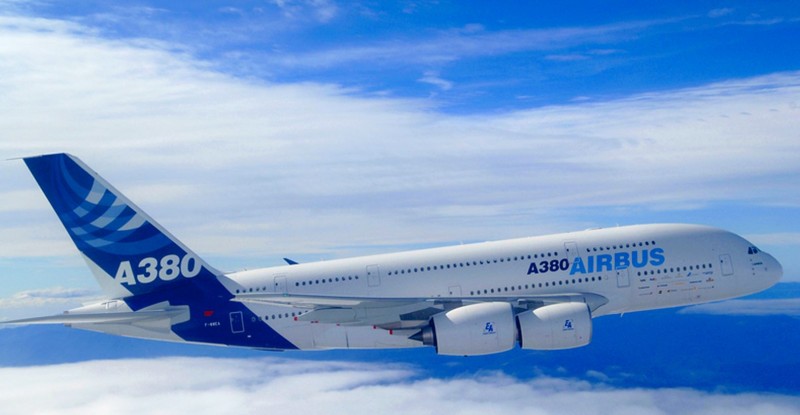Airbus and aircraft lessor Amedeo (formerly Doric) recently organized a presentation for investors and media in New York, where they laid out the case for the Airbus A380 with US carriers, and pitched a new 11-abreast configuration. Noticeably absent in the A380 order book are the trio of major US carriers: American, Delta and United. Both Delta and United operate the 747-400, which previously held the title as world’s largest passenger plane, and are sales targets for Airbus.
Amedeo and Airbus highlighted the A380’s superior economics as a major selling point for American carriers, which of late have been on a crusade to drive down CASM in their fleets. While the operating efficiencies of a full A380 are very difficult to beat, the key word being “full”, there is another major barrier to A380 sales to US carriers.
One business that was hit particularly hard in the global financial crisis was air freight. While air travel has come back, the lack of a rebound in the air cargo market has been conspicuous. One common theme across the A380 fleet is that all but one of the carriers that operate it also have dedicated cargo arms. British Airways is the single outlier; it recently disbanded its joint venture with Atlas Air, opting for a capacity purchase agreement with Oneworld partner Qatar Airways. The majority of British Airways’ cargo is carried in the belly of its passenger aircraft, as is the case with all US carriers. The shifting economics that required a re-evaluation of seat counts on the A380 had a knock-on effect. It led to reduced belly cargo capacity in A380s because more under-floor cargo volume had to be dedicated to passenger baggage.
In contrast with the A380, Boeing’s 777-300ER and other big twins shine in their ability to produce revenue from both passenger and cargo operations simultaneously. American Airlines became an operator of the 777-300ER in February 2013, and the model began operating between Los Angeles and London in June 2013. In February of this year, AA Cargo announced that one of its aircraft had operated a flight between LAX and London Heathrow with 50 tons of belly cargo, in addition to a full passenger load. For reference, the maximum payload for a 777 freighter is 113 tons. This revenue diversification is both a huge profit driver and an incredible risk neutralizer. It is a feature of big twins like the 777-300ER as well as Airbus’s A350-1000 and Boeing’s upcoming 777X. The combination of passenger and cargo revenues drastically reduces the possibility that any given flight will fail to cover its operational costs.
The US airline industry was transformed by the global financial crisis, arguably more than any other country. September 11 brought the US airline industry to to its knees, and global financial crisis followed seven short years later. Consolidation, bankruptcies and the 2008 oil spike transformed the surviving carriers into a disciplined and risk averse trio of airlines. They have been rewarded with renewed stability and record profits. With the memories of 2008 still fresh in their minds, they will be loathe to deviate from the strategy that brought them back to financial health. Unfortunately for Airbus and Amedeo, this financial health comes at the expense of the A380 order book.
Amedeo CEO Mark Lapidus, who believes Delta in particular is a great candidate for the A380 even though Delta thinks otherwise, disputes my assertion above. In a lengthy statement to RGN, Lapidus said,
“A good way to ruin an airline is to compromise passenger routes and run it as if it were a cargo operation. Indeed, B777-300ER is a great belly cargo aircraft, but extra 15 tons of cargo it can carry provide, which is a number I have heard from airlines operating both A380 and B777, but happy to make it 20 tons for the sake of argument, are worth in revenues in the ballpark of maybe 30 to 40 (in stretched case) economy seats.
“A380 provides, in comparable comfort configurations* [see below] more than 130 extra seats, many in premium cabins and do the same job at 25% to 29% less unit cost per seat. It should be a logical decision on the right routes where there are no more benefits of extra frequencies that can be gained from connectivity or customer demand – like BA having flights out of JFK to LHR at 18:40 (BA 112), at 19:00 20 minutes later (BA 174), then 30 minutes later at 19:30 (BA 176), and then their partner AA has a flight at 19:30 as well, than more flights at 20:40 (BA 116), AA has a flight at 20:45 as well, than at 21:30 (BA 172), than 20 minutes later at 21:50 (BA 114), and there are two more flights between 21:00 and 23:00 from Newark, with the last BA leaving at 22:55 – to use the A380.
“The argument that customers like frequencies loses luster when intercontinental flights are departing 20 minutes apart. There are transpacific flights, as well as others, where the extra frequencies do not add connectivity value or it is about the right time channels, for which airlines will earn higher yield. I think IAG stock is a buy – BA has so much more potential for both cost savings and productivity when they will eventually rationalize NY with the A380, and also deploy valuable morning slots at LHR elsewhere in the growing world. A380 cargo minus is more than compensated by its passenger advantage.”
Lapidus mentions a number of seat counts for different aircraft, and pegs the A380 at 590. But that’s greater than 10% more seats than anyone is flying them with right now. The A380 is a great plane if you can fill it, but the highest seat count today (LH at 526) is 40% greater than the highest seat count plane amongst US carriers (DL 744, 376). That’s a huge jump. I believe a bird in the hand (current cargo revenue) is worth two in the bush (potential revenue from flying more 40% more seats). He’s asking carriers to give up an established revenue stream in favor of his plane, but as long as carriers don’t feel they can hit the loads required on an A380 to make up for that, they’re not going to make the commitment.
Additionally, the point about the redundancy of BA’s JFK-LHR schedule, and how A380s will be used to consolidate it, doesn’t play with me. The departure sequence in the evening is a product of the fact that there’s only really a 6-hour take off window for JFK-LHR flights, but a 12 hour one for LHR-JFK. Flights come to JFK spaced an hour apart, but leave at tighter intervals. Also, as long as BA is in T7 (which it owns) there will be no BA A380s at JFK. It’s too small.
*590 in four seat configuration to A350-100 317, B777-9X 341 (10 abreast), and B777-300ER 306 (9 abreast) or three class with 602, 329, 320, 357, respectively, and two class with 614, 352, 333, 376.













